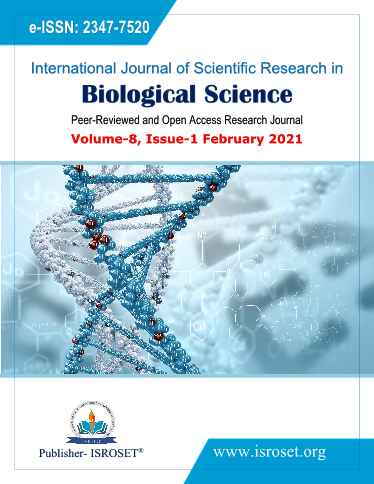The Effect of Herbal Treatment against Tick
Keywords:
Extract, Azadirachta indica, Allium sativum, ticksAbstract
The present study was done with the use of effective herbal plant extracts against ticks to estimate the acaricidal activity. Two herbal plant i.e. Azadirachta indica (Neem) and Allium sativum (Garlic) were used as an extract against different species of ticks (Hyalomma anatolicum, Boophilus microplus and Rhiphicephalus) which were highly reactive to ticks mortality. In the present study, when Allium sativum plant extracts were used it showed 100 % tick mortality within 43 minutes and Azadirachta indica showed 100 % tick mortality within 30 minutes The combination of both the plant extracts showed 100 % tick mortality within 20 minutes.
References
Sanelson, J.T., “Animal ectoparasites and diseases vector causing major reduction in world food supplies,” FAO Plant Protection Bulletin,1975.
Latif, A. and Jongejan, F., “The wide use of acaricide for the control of livestock diseases in Africa needs a reappraisal,” Institute of Tropical medicine, Anturerp, Belgium, 2002.
Regassa, A. and Castro, D. J.,“Tick resistance to acaricides in western Ethiopia,”Tropical Animal Health and Production, 25: 69–74,1993.
Palmer, W. A., Dingle, J. H. P. and Heat, A. B., “Residue of chlordimeformin bovine tissues and milk following application by a hand spray,” Australian Journal of Experimental Agriculture and Animal Husbandry, 17: 380–384,1977.
Boeke, S.J., Baumgart, I.R., Loon, J.J.A., Huis, A., Dicke, M. and Kossou, D.K., “Toxicity and repellence of African plants traditionally used for the protection of stored cowpea against Callosobruchus maculatus, ” J. Stored. Prod. Res, 40: 423-438,2004.
Liang, G.M., Chen, W. and Liu, T.X.,“Effects of three neem based insecticides on diamondback moth (Lepidoptera: Plutellidae),” Crop Protection, 22: 333-40, 2003.
Sutherland, J.P., Baharally, V. and Permaul, D., “Use of the botanical insecticide, neem to control the small rice stinkbug Oebalus poecilus (Hemiptera: Pentatomidae) in Guyana Entomotropica, ” 17(1): 97–101,(2002).
Soulsby, E.J.L. Helminthes,“Arthopods and protozoa of domesticated animals (monnig) Philadelphia, ”lea & febiger,1968.
Magano S.R., Thembo K.M., Ndlovu S.M., Makhubela N. F. H., “The anti-tick properties of the root extract of Senna italica subsp. arachoides,” African Journal of Biotechnology, Vol. 7 (4): 476- 481,2008.
Parte, S.G., Patil, R.D., Patil, M.A., Patel N.S. and Chavan J.A., “Utilization of herbals for the managements of cattle ticks,” Int.J.Curr. Microbiol. App.Sci, 3 (10) : 228-232, 2014.
Regassa, A. “The use of herbal preparations for tick control in western Ethiopia , ” Journal of the South African Veterinary Association, 71(4): 240–243,2000.
Downloads
Published
How to Cite
Issue
Section
License

This work is licensed under a Creative Commons Attribution 4.0 International License.
Authors contributing to this journal agree to publish their articles under the Creative Commons Attribution 4.0 International License, allowing third parties to share their work (copy, distribute, transmit) and to adapt it, under the condition that the authors are given credit and that in the event of reuse or distribution, the terms of this license are made clear.







